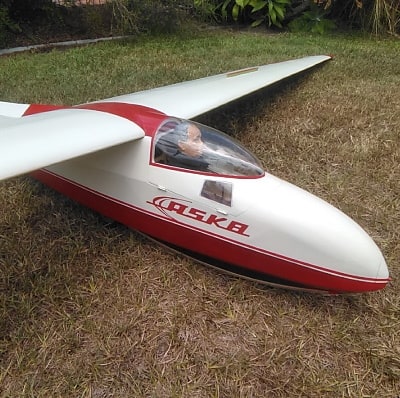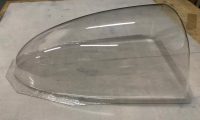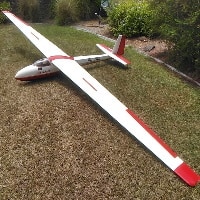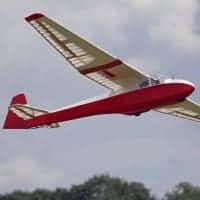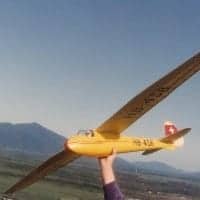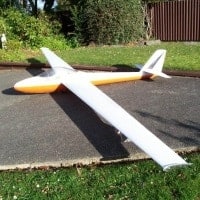Description
Schleicher K-8 K-8B
K-8 Design and development
The K-8 was derived from the earlier Ka-6 design as a simple single-place sailplane with air brakes using construction techniques similar to the Schleicher K-7, simplified for amateur construction from kits. Emphasis was on rugged construction, good climbing ability in thermals and good handling characteristics.
The prototype K-8 made its first flight in November 1957 and over 1,100 were built in three main versions. The original K-8 had a very small canopy. Side windows for improved visibility were introduced in the next version, and the K-8B, by far the most numerous variant, has a larger one-piece blown Plexiglas canopy. The K-8C features a longer nose, larger main wheel located ahead of the centre of gravity and deletion of the larger wooden nose skid resulting in a roomier cockpit.
The cantilever high wings are single-spar structures of pine and plywood, with a plywood leading edge torsion box and fabric covering aft of the spar; the forward sweep is 1° 18′ and dihedral is 3°. There are Schempp-Hirth air brakes in the upper and lower surfaces and the wooden ailerons are plywood covered. The cantilever tail unit is of similar construction to the wings, with ply-covered fixed surfaces and fabric-covered rudder and elevators, and a trim tab in the elevator is an optional fitting. The fuselage is a welded steel-tube structure, with fabric covering over spruce longerons and a glass fibre nose cone.
There is a non-retractable and unsprung monowheel, with optional brake, and a nose skid mounted on rubber blocks in front of it, plus a steel skid at the tail.
Operational history
Karl Striedieck of the United States made a 767 km / 476.6-mile ridge flight in a K-8B to establish a world out-and-return record in 1968.
Motor glider variants
A motor glider conversion of the K-8B was developed by LVD (the Flying Training School of the Detmold Aero Club) similar to their conversion of a Scheibe Bergfalke IV known as the BF IV-BIMO, in which a Lloyd LS-400 piston engine mounted in the fuselage drives a pair of small two-blade pusher propellers rotating within cutouts in each wing near the trailing edge.
Another motor-glider conversion was used by “Vestjysk Svæveflyveklub” in Denmark: it had a small Wankel rotary engine mounted in a nacelle on an aluminium stick above the main spar. The engine was started with a recoil starter like a lawnmower. The high RPM of the device made it extremely unpopular: the propeller tips created a permanent sonic boom, that made the plane extremely noisy. The harassed citizens of Esbjerg nicknamed the plane ‘the flying circular saw’ and the engine was removed.
Specifications (K-8B)
Data from The World’s Sailplanes:Die Segelflugzeuge der Welt:Les Planeurs du Monde Volume II
General characteristics
Crew: 1
Length: 7 m (23 ft 0 in)
Wingspan: 15 m (49 ft 3 in)
Wing area: 14.15 m2 (152.3 sq ft)
Aspect ratio: 15.9
Airfoil: Root: Göttingen 533 16.7%,Mid: Göttingen 533, Tip: Göttingen 532
Empty weight: 191 kg (421 lb)
Gross weight: 310 kg (683 lb)
Performance
Stall speed: 55 km/h (34 mph, 30 kn)
Never exceed speed: 200 km/h (120 mph, 110 kn)
Rough air speed max: 130 km/h (80.8 mph; 70.2 kn)
Aerotow speed: 130 km/h (80.8 mph; 70.2 kn)
Winch launch speed: 100 km/h (62.1 mph; 54.0 kn) (60kn with Tost blue cable weak link)
Terminal velocity: with full airbrakes 207 km/h (129 mph; 112 kn)
Minimum control speed: 70 km/h (43 mph, 38 kn) no ballast, full flaps
g limits: +4 -2 at 151 km/h (93.8 mph; 81.5 kn)
Maximum glide ratio: 27 at 73 km/h (45.4 mph; 39.4 kn)
Rate of sink: 0.67 m/s (132 ft/min) at 60 km/h (37.3 mph; 32.4 kn)
Wing loading: 21.8 kg/m2 (4.5 lb/sq ft)
